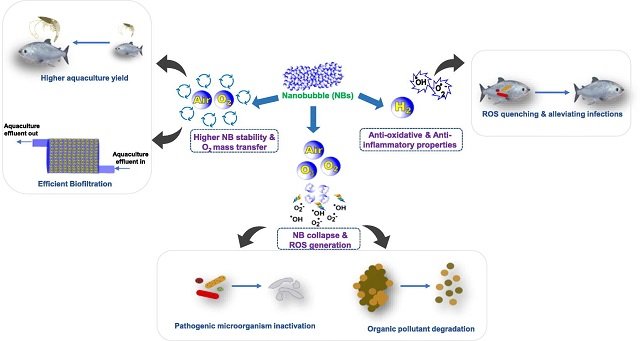
In the current pursuit of sustainable aquaculture practices, addressing water quality in aquaculture ponds before harvest, known as tailwater, is a critical consideration.
Tailwater from aquaculture has become a major contributor to the eutrophication of water bodies. Despite advancements in breeding technology, feed development, and aeration optimization, pond aquaculture has caused significant environmental damage.
In this context, the question arises: How can we efficiently use water in aquaculture ponds?
A team of scientists from Nanjing Agricultural University and the Freshwater Fisheries Research Center conducted an experiment to explore the effects of adding molasses to pre-treat aquaculture tailwater. The goal was to meet standards and analyze the responses and functions of the microbial community in this process.
Molasses: A Sustainable Solution for Tail Water Quality
The primary sources of pollution in aquaculture tail water include food waste, animal metabolites, and sediments. Treatment methods include sedimentation, filtration, and biological processes, often requiring a portion of the pond area for water purification.
Molasses, a byproduct of the sugar industry, offers the advantages of being inexpensive, easily accessible, and widely used as a food additive in animal farming. In aquaculture, molasses is frequently used to provide nutrients, regulate physiological mechanisms, and improve the quality of products for aquatic animals.
The experiment involved in-situ molasses addition to tilapia pond culture 58 days before harvest. The results were impressive, showing a significant reduction in total phosphorus, total nitrogen, and three types of inorganic nitrogen in aquaculture tail water. The linear impact on nitrate and nitrite nitrogen was particularly notable, and this effect was mediated by the responses of bacterioplankton communities.
Revealing Bacterioplankton Communities
Analysis of bacterioplankton communities highlighted Proteobacteria and Bacteroidetes as dominant players, emphasizing their correlation with physicochemical parameters of water quality. The study used the FAPROTAX software to predict bacterial function, identifying prevalent chemoheterotrophic bacteria in tail water. Additionally, the abundance of functional microorganisms associated with the nitrogen and phosphorus cycle was notably high.
Stay Always Informed
Join our communities to instantly receive the most important news, reports, and analysis from the aquaculture industry.
Unleashing the Potential of Molasses
A fascinating revelation from the study is that the growth-promoting effect of molasses on cultivated organisms may not be attributed to the ingestion of biofloc by animals but could be a direct impact of molasses itself. This challenges conventional wisdom and offers a new perspective on the multifaceted roles that molasses can play in aquaculture systems.
Benefits Beyond Water Quality
The study’s findings highlighted that the addition of molasses had a significant impact on various water quality parameters. However, beyond its impact on water quality, the addition of molasses emerged as a holistic solution. Not only did it alleviate the pressure of environmental purification, but it also induced significant alterations in the structure of the microbial community. This, in turn, enhanced the nitrogen cycling capacity of the aquatic environment and promoted the growth of cultured animals.
Implications for Sustainable Aquaculture
In conclusion, this study demonstrates that molasses is the key to improving the quality of aquaculture tail water, paving the way for a more sustainable and environmentally conscious approach.
“The pre-treatment of aquaculture tail water through the addition of molasses 14 days before discharge can enhance the removal of nitrogen and phosphorus. The addition of molasses significantly influences the structure and function of the microbial community, particularly in the metabolism of heterotrophic microorganisms in tailwater,” concluded the scientists.
The findings provide a theoretical basis for the practical application of molasses in the in-situ pre-treatment of aquaculture tail water, offering a promising solution to enhance the overall sustainability of aquaculture practices.
For both aquaculture enthusiasts and environmental advocates, embracing molasses as a strategic ally in tail water management could mark a significant step towards a more sustainable and prosperous aquatic ecosystem.
The study was funded by the Agriculture Research System of China of MOF and MARA and the Central Public-interest Scientific Institution Basal Research Fund, CAFS.
Contact
Shunlong Meng
Freshwater Fisheries Research Center
Chinese Academy of Fishery Sciences, Scientific Observing and Experimental Station of Fishery Resources and Environment in the Lower Reaches of the Yangtze River
Wuxi 214081, China.
Email:mengsl@ffrc.cn
Reference
Yong Yang, Limin Fan, Xinchi Wang, Xi Chen, Liping Qiu, Huimin Xu, Dandan Li, Chao Song, Shunlong Meng, Jiazhang Chen. 2023. In-situ pretreatment of aquaculture tail water by molasses addition and the responses of bacterioplankton communities, Journal of Water Process Engineering, Volume 56, 2023, 104526, ISSN 2214-7144, https://doi.org/10.1016/j.jwpe.2023.104526.
Editor at the digital magazine AquaHoy. He holds a degree in Aquaculture Biology from the National University of Santa (UNS) and a Master’s degree in Science and Innovation Management from the Polytechnic University of Valencia, with postgraduate diplomas in Business Innovation and Innovation Management. He possesses extensive experience in the aquaculture and fisheries sector, having led the Fisheries Innovation Unit of the National Program for Innovation in Fisheries and Aquaculture (PNIPA). He has served as a senior consultant in technology watch, an innovation project formulator and advisor, and a lecturer at UNS. He is a member of the Peruvian College of Biologists and was recognized by the World Aquaculture Society (WAS) in 2016 for his contribution to aquaculture.




